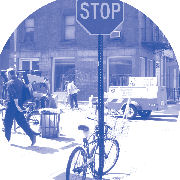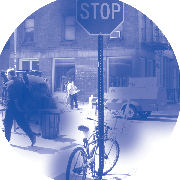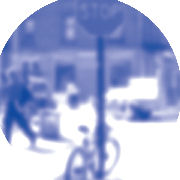Impairment and Diabetes: 5 Key Messages
- "Impairment and Diabetes: 5 Key Messages" is also available as a printable PDF. (PDF)
1 - New Yorkers with diabetes and pre-diabetes are at high risk for diabetic eye diseases such as retinopathy, glaucoma and cataracts.
- Diabetes is a growing epidemic. More than 1 million adults in New York State have diabetes and another 760,000 adult New Yorkers have diabetes and don't know it. Diabetes is the leading cause of new cases of blindness in adults 20-74 years of age.
- Diabetic retinopathy (DR) can lead to blindness. DR is a complication of diabetes that damages the eye's retina. DR is more likely to develop the longer a person has diabetes, particularly if the diabetes is poorly controlled. As there are often no symptoms in the early stages of DR, a dilated eye exam is critical to diagnosing retinopathy and preventing vision loss.

Normal vision
Diabetic retinopathy- Glaucoma is a group of diseases that damage the eye's optic nerve and can result in vision loss and blindness. A person with diabetes is 40% more likely to get glaucoma as other adults. About 7% of New Yorkers aged 40 years and older with diabetes have glaucoma.

Normal vision
Glaucoma- A cataract is the clouding of the eye's lens that causes vision problems. A person with diabetes is 60% more likely to develop cataracts. About 30% of New Yorkers aged 40 years and older with diabetes either currently have cataracts or have had them removed. Cataracts also develop at an earlier age in people with diabetes.

Normal vision
Cataracts
Photos courtesy of Lighthouse International
2 - An annual dilated eye exam is essential for all New Yorkers with diabetes to prevent or slow the progression of vision loss.
- Early diagnosis and timely treatment of diabetes has been shown to prevent vision loss in more than 90% of patients. Good control of blood sugar, blood pressure and cholesterol is very important to reduce vision loss in people with diabetes.
- The American Diabetes Association Clinical Practice Recommendations indicate all people with diabetes should receive an annual dilated eye exam.
- Approximately one in five people with type 2 diabetes have retinopathy when they are first diagnosed with diabetes and about half of patients are diagnosed with diabetic retinopathy too late for treatment to be effective.
3 - People with diabetes need more education about potential vision loss and the need for yearly dilated eye exams.
- In New York State, only 60% of individuals with diabetes in commercial and Medicaid managed care plans have received a dilated eye exam in the past two years.
- Among New Yorkers aged 40 years and older, the most frequent reason given for not visiting an eye care professional in the past 12 months was because "they had no reason to go." This was true for both people with and without diabetes.
4 - Diabetic retinopathy is a growing public health concern for New York State.
- Diabetic retinopathy has been diagnosed in 19.4% of adult New Yorkers with diabetes. However, it is estimated that one in three patients with diabetes, and half of people with diabetes aged 45-65 years, have some stage of diabetic retinopathy.
- Among adult New Yorkers with diabetes, diabetic retinopathy has been found to dispropor - tionately affect the non-Hispanic Black population (31%) and the Hispanic population (35%) as compared to the non-Hispanic white population (16%).
- Diabetic retinopathy can occur during the pre-diabetes stage and up to seven years before diagnosis of type 2 diabetes. An estimated 3.7 million adult New Yorkers have pre-diabetes, a condition where blood glucose levels are higher than normal, but not high enough to be diagnosed as diabetes. An eye exam can lead to an earlier diagnosis of diabetes for people who do not know they have the disease.
- Over the next 30 years, the number of people in the U.S. diagnosed with diabetes is expected to triple. As a result, the number of individuals 40 years and older diagnosed with diabetic retinopathy or cataracts is expected to triple, and the number with glaucoma is expected to quadruple.
5 - Blindness and vision impairment are major public health problems causing a substantial human and economic toll on individuals and society.
- Vision impairment affects people's ability to drive, read, learn and attend to household and personal tasks.
- Reduced vision can result in social isolation, increased risk of falling, depression, familial stress and a greater tendency to experience disability or die prematurely.
State of New York Department of Health
Publication 0939 Version 11/10
Prepared by the Vision Health Integration and Preservation Program, a collaboration of Healthy Eyes Alliance (formerly Prevent Blindness Tri-State) and the New York State Department of Health.